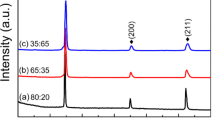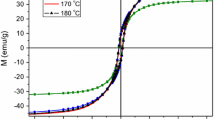Abstract
Fe-Ni core-shell nanoparticles are versatile functional materials, and their thermal stabilities are crucial for their performances in operating conditions. In this study, the thermodynamic behaviors of Fe-Ni core-shell nanoparticles are examined under continuous heating. The solid-solid phase transition from body centered cubic (bcc) to face centered cubic (fcc) in the Fe core is identified. The transition is accompanied with the generation of stacking faults around the core-shell interface, which notably lowers the melting points of the Fe-Ni core-shell nanoparticles and causes even worse thermal stability compared with Ni ones. Moreover, the temperature of the structural transformation is shown to be tuned by modifying the Ni shell thickness. Finally, the stress distributions of the core and the shell are also explored. The relevant results could be helpful for the design, preparation, and utilization of Fe-based nanomaterials.
Similar content being viewed by others
References
V. Amendola, P. Riello, and M. Meneghetti, Magnetic nanoparticles of iron carbide, iron oxide, iron@iron oxide, and metal iron synthesized by laser ablation in organic solvents, J. Phys. Chem. C 115(12), 5140 (2011)
D. L. Huber, Synthesis, properties, and applications of iron nanoparticles, Small 1(5), 482 (2005)
Z. Y. Zhou, N. Tian, J. T. Li, I. Broadwell, and S. G. Sun, Nanomaterials of high surface energy with exceptional properties in catalysis and energy storage, Chem. Soc. Rev. 40(7), 4167 (2011)
Y. X. Chen, S. P. Chen, Z. Y. Zhou, N. Tian, Y. X. Jiang, S. G. Sun, Y. Ding, and Z. L. Wang, Tuning the shape and catalytic activity of Fe nanocrystals from rhombic dodecahedra and tetragonal bipyramids to cubes by electrochemistry, J. Am. Chem. Soc. 131(31), 10860 (2009)
L. M. Lacroix, N. F. Huls, D. Ho, X. L. Sun, K. Cheng, and S. H. Sun, Stable single-crystalline body centered cubic Fe nanoparticles, Nano Lett. 11(4), 1641 (2011)
A. K. Gupta and M. Gupta, Synthesis and surface engineering of iron oxide nanoparticles for biomedical applications, Biomaterials 26(18), 3995 (2005)
X. Zhao, W. Liu, Z. Q. Cai, B. Han, T. W. Qian, and D. Y. Zhao, An overview of preparation and applications of stabilized zero-valent iron nanoparticles for soil and groundwater remediation, Water Res. 100, 245 (2016)
T. Phenrat, D. Schoenfelder, T. L. Kirschling, R. D. Tilton, and G. V. Lowry, Adsorbed poly(aspartate) coating limits the adverse effects of dissolved groundwater solutes on Fe0 nanoparticle reactivity with trichloroethylene, Environ. Sci. Pollut. Res. Int. 25(8), 7157 (2018)
A. P. Douvalis, R. Zboril, A. B. Bourlinos, J. Tucek, S. Spyridi, and T. Bakas, A facile synthetic route toward air-stable magnetic nanoalloys with Fe-Ni/Fe-Co core and iron oxide shell, J. Nanopart. Res. 14(9), 1130 (2012)
S. F. Moustafa and W. M. Daoush, Synthesis of nano-sized Fe-Ni powder by chemical process for magnetic applications, J. Mater. Process. Technol. 181(1–3), 59 (2007)
P. Tartaj, M. P. Morales, S. Veintemillas-Verdaguer, T. González-Carreño, and C. J. Serna, The preparation of magnetic nanoparticles for applications in biomedicine, J. Phys. D Appl. Phys. 36(13), R182 (2003)
S. K. Sanjay, A. K. Singh, K. Aranishi, and Q. Xu, Noble-metal-free bimetallic nanoparticle-catalyzed selective hydrogen generation from hydrous hydrazine for chemical hydrogen storage, J. Am. Chem. Soc. 133(49), 19638 (2011)
S. A. Theofanidis, V. V. Galvita, H. Poelman, and G. B. Marin, Enhanced carbon-resistant dry reforming Fe-Ni catalyst: Role of Fe, ACS Catal. 5(5), 3028 (2015)
Y. H. Tee, L. Bachas, and D. Bhattacharyya, Degradation of trichloroethylene by iron-based bimetallic nanoparticles, J. Phys. Chem. C 113(22), 9454 (2009)
M. Rivero-Huguet and W. D. Marshall, Reduction of hexavalent chromium mediated by micro- and nano-sized mixed metallic particles, J. Hazard. Mater. 169(1–3), 1081 (2009)
G. Bonny, R. C. Pasianot, and L. Malerba, Fe-Ni many-body potential for metallurgical applications, Model. Simul. Mater. Sci. Eng. 17(2), 025010 (2009)
K. Vörtler, N. Juslin, G. Bonny, L. Malerba, and K. Nordlund, The effect of prolonged irradiation on defect production and ordering in Fe-Cr and Fe-Ni alloys, J. Phys.: Condens. Matter 23(35), 355007 (2011)
N. Anento, A. Serra, and Y. Osetsky, Effect of nickel on point defects diffusion in Fe-Ni alloys, Acta Mater. 132, 367 (2017)
C. G. Zhang, K. Ma, N. Q. Zhao, and Z. H. Yuan, A core-shell strategy for improving alloy catalyst activity for continual growth of hollow carbon onions, Cryst. Growth Des. 18(12), 7470 (2018)
Y. Qi, T. Cagin, W. L. Johnson, and W. A. III Goddard, Melting and crystallization in Ni nanoclusters: The mesoscale regime, J. Chem. Phys. 115(1), 385 (2001)
R. Huang, Y. H. Wen, Z. Z. Zhu, and S. G. Sun, Thermal stability of platinum nanowires: a comparison study between single-crystalline and twinned structures, J. Mater. Chem. 21(47), 18998 (2011)
Q. S. Mei and K. Lu, Melting and superheating of crystalline solids: from bulk to nanocrystals, Prog. Mater. Sci. 52(8), 1175 (2007)
Y. Shibuta and T. Suzuki, Melting and nucleation of iron nanoparticles: A molecular dynamics study, Chem. Phys. Lett. 445(4–6), 265 (2007)
R. Huang, Y. H. Wen, Z. Z. Zhu, and S. G. Sun, Structure and stability of platinum nanocrystals: From low-index to high-index facets, J. Mater. Chem. 21(31), 11578 (2011)
C. Kittel, Introduction to Solid State Physics, John Wiley & Sons Press, 1956
R. Huang, Y. H. Wen, Z. Z. Zhu, and S. G. Sun, Pt-Pd bimetallic catalysts: Structural and thermal stabilities of core-shell and alloyed nanoparticles, J. Phys. Chem. C 116(15), 8664 (2012)
J. D. Honeycutt and H. C. Andersen, Molecular-dynamics study of melting and freezing of small Lennard-Jones clusters, J. Phys. Chem. 91(19), 4950 (1987)
L. Sandoval, H. M Urbassek, and P. Entel, The Bain versus Nishiyama-Wassermann path in the martensitic transformation of Fe, New J. Phys. 11(10), 103027 (2009)
R. Huang, S. F. Shao, X. M. Zeng, and Y. H. Wen, Diverse melting modes and structural collapse of hollow bimetallic core-shell nanoparticles: A perspective from molecular dynamics simulations, Sci. Rep. 4(1), 7051 (2015)
R. Huang, Y. H. Wen, Z. Z. Zhu, and S. G. Sun, Atomicscale insights into structural and thermodynamic stability of Pd-Ni bimetallic nanoparticles, Phys. Chem. Chem. Phys. 18(14), 9847 (2016)
C. Mottet, G. Rossi, F. Baletto, and R. Ferrando, Single impurity effect on the melting of nanoclusters, Phys. Rev. Lett. 95(3), 035501 (2005)
D. Srolovitz, K. Maeda, V. Vitek, and T. Egami, Structural defects in amorphous solids Statistical analysis of a computer model, Philos. Mag. A 44(4), 847 (1981)
Y. T. Cheng, and M. W. Verbrugge, The influence of surface mechanics on diffusion induced stresses within spherical nanoparticles, J. Appl. Phys. 104(8), 083521 (2008)
V. I. Levitas and K. Samani, Size and mechanics effects in surface-induced melting of nanoparticles, Nat. Commun. 2(1), 284 (2011)
H. Hasegawa and D. G. Pettifor, Microscopic theory of the temperature-pressure phase diagram of iron, Phys. Rev. Lett. 50(2), 130 (1983)
Acknowledgements
This work was supported by the National Natural Science Foundation of China (Grant Nos. 11474234 and 51871189).
Author information
Authors and Affiliations
Corresponding authors
Rights and permissions
About this article
Cite this article
Wang, JB., Huang, R. & Wen, YH. Thermally activated phase transitions in Fe-Ni core-shell nanoparticles. Front. Phys. 14, 63604 (2019). https://doi.org/10.1007/s11467-019-0932-1
Received:
Accepted:
Published:
DOI: https://doi.org/10.1007/s11467-019-0932-1




